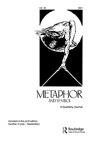A metaphor is not like a simile: reading-time evidence for distinct interpretations for negated tropes
IF 3.3
3区 文学
0 LANGUAGE & LINGUISTICS
引用次数: 1
Abstract
ABSTRACT Studies have suggested that metaphors (Lawyers are sharks) and similes (Lawyers are like sharks) have distinct representations: metaphors engender more figurative and abstract properties, whereas similes engender more literal properties. We investigated to what extent access to such representations occurs automatically, during on-line reading. In particular, we examined whether similes convey a more literal meaning by following the metaphors and similes with explanations that expressed either a figurative (dangerous) or a literal property (fish) of the vehicle. In a self-paced reading with a moving window paradigm, we presented participants with negated simile and metaphor main clauses (Lawyers are not (like) sharks) followed by explanations that also negated either a figurative (because lawyers are not dangerous) or a literal property of the vehicle (because lawyers are not fish). We found that vehicles (sharks) in metaphors were read significantly faster than those in similes. In addition, explanations negating a figurative property were read faster after metaphors, whereas explanations negating a literal property were read faster after similes. These results support the hypothesis that metaphors and similes rely on different interpretive processes, suggesting that similes access literal representations while metaphor access figurative ones in real time.隐喻不像明喻:阅读时间证据,对否定的比喻进行不同的解释
摘要研究表明,隐喻(律师是鲨鱼)和明喻(律师像鲨鱼)具有不同的表征:隐喻产生更多的具象和抽象属性,而明喻产生更多的字面属性。我们调查了在线阅读过程中自动访问这些表示的程度。特别是,我们研究了明喻是否通过遵循隐喻和明喻的解释来传达更字面的含义,这些解释表达了车辆的比喻(危险)或字面属性(鱼)。在一个移动窗口范式的自定节奏阅读中,我们向参与者展示了否定的明喻和隐喻主句(律师不是(像)鲨鱼),然后是否定比喻(因为律师不危险)或车辆字面属性(因为律师不是鱼)的解释。我们发现隐喻中的载体(鲨鱼)比明喻中的载体读得快得多。此外,否定比喻性质的解释在隐喻之后读得更快,而否定字面性质的解释则在明喻之后读得更快。这些结果支持了隐喻和明喻依赖于不同的解释过程的假设,表明明喻实时获取字面表征,而隐喻实时获取比喻表征。
本文章由计算机程序翻译,如有差异,请以英文原文为准。
求助全文
约1分钟内获得全文
求助全文
来源期刊

Metaphor and Symbol
Multiple-
CiteScore
2.90
自引率
0.00%
发文量
23
期刊介绍:
Metaphor and Symbol: A Quarterly Journal is an innovative, multidisciplinary journal dedicated to the study of metaphor and other figurative devices in language (e.g., metonymy, irony) and other expressive forms (e.g., gesture and bodily actions, artworks, music, multimodal media). The journal is interested in original, empirical, and theoretical research that incorporates psychological experimental studies, linguistic and corpus linguistic studies, cross-cultural/linguistic comparisons, computational modeling, philosophical analyzes, and literary/artistic interpretations. A common theme connecting published work in the journal is the examination of the interface of figurative language and expression with cognitive, bodily, and cultural experience; hence, the journal''s international editorial board is composed of scholars and experts in the fields of psychology, linguistics, philosophy, computer science, literature, and media studies.
 求助内容:
求助内容: 应助结果提醒方式:
应助结果提醒方式:


